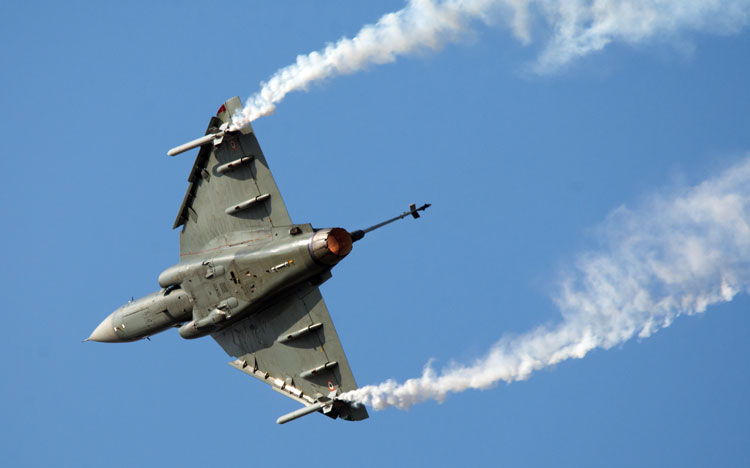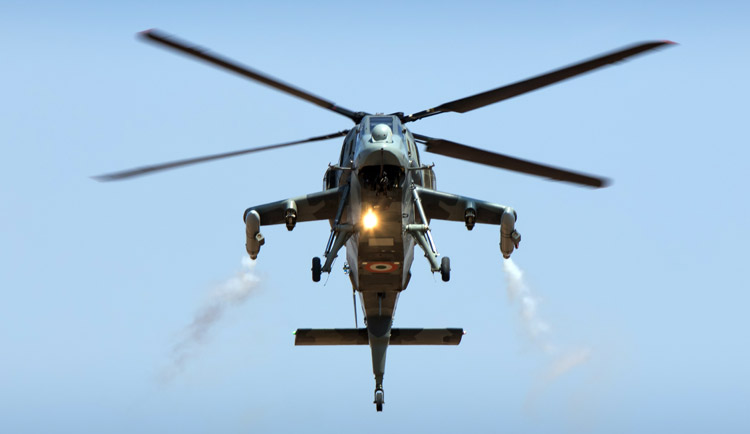INDIAN ARMED FORCES CHIEFS ON OUR RELENTLESS AND FOCUSED PUBLISHING EFFORTS

The insightful articles, inspiring narrations and analytical perspectives presented by the Editorial Team, establish an alluring connect with the reader. My compliments and best wishes to SP Guide Publications.

"Over the past 60 years, the growth of SP Guide Publications has mirrored the rising stature of Indian Navy. Its well-researched and informative magazines on Defence and Aerospace sector have served to shape an educated opinion of our military personnel, policy makers and the public alike. I wish SP's Publication team continued success, fair winds and following seas in all future endeavour!"

Since, its inception in 1964, SP Guide Publications has consistently demonstrated commitment to high-quality journalism in the aerospace and defence sectors, earning a well-deserved reputation as Asia's largest media house in this domain. I wish SP Guide Publications continued success in its pursuit of excellence.
- Prime Minister Modi Visits Punjab’s Adampur Air Base, Interacts with Airmen after Successful ‘Operation Sindoor’; Stern Message to Pakistan
- The layered Air Defence systems that worked superbly, the key element of Operation Sindoor
- Operation Sindoor | Day 2 DGMOs Briefing
- Operation Sindoor: India strikes back with Precision and Purpose
- Operation Sindoor: Resolute yet Restrained
- India’s Operation Sindoor Sends a Clear Message to Terror and the World – ‘ZERO TOLERANCE’
- Japan and India set forth a defence cooperation consultancy framework, talks on tank and jet engines
- Terrorist Attack in Pahalgam in Kashmir: Unfolding a long surgical war against PAK
- Lt General Pratik Sharma takes over Command of Indian Army's Northern Command
The best bet is to bet on yourself
Grow from 'Make in India' to 'Innovate in India' to boost India's defence ecosystem and transform Indigenous manufacturing
Recently, the government has released the fourth negative import list that enumerates the defence equipment which cannot be procured from abroad. Ergo, these items and those listed in the preceding such lists have to be 'Made in India'. The larger goal that has been set by the Defence Minister is for India to be self reliant by the year 2047. To make the environment conducive and to enable wider participation by the Indian industry, the Government of India has rolled out schemes like the 'Make' procedure, the Technical Development Fund and the iDEX Scheme. These schemes endeavour to help capable, but smaller players in order that the defence ecosphere gets an overall boost.
Notwithstanding these endeavours, various international studies show that India's defence imports have not shown a significant reduction in absolute numbers. The factors for this are numerous and include a yet-to-mature Research and Development environment plus the influx of capital that would enable it. This lack of capital inflow has implied a relatively limited defence production by India's private sector. One study states their contribution as being a mere 25 per cent - by all accounts this is a pittance of what can be.
The government has introduced initiatives like the 'Make' procedure, Technical Development Fund, and iDEX Scheme to support smaller players and enhance the overall defence ecosystem.
India's defence import figures belie the size of the size of the market that is available in the country. Whilst the public at large is generally aware only of big ticket purchases like aircraft, ships and tanks, the potential for domestic involvement consists of two possible verticals for manufacturers - that involving sustenance of existing equipment, besides the capital procurement of equipment. Whilst the former offers an avenue of recurring sales, the latter generally pertains to large one-time orders. Whilst it is easy to lay the blame at the door of domestic manufacturers, the requirements of the defence sector are very stringent, making the learning curve very steep for new entrants to the sector.
Here too, the aerospace sector poses unique challenges which generally deter those seeking to get involved in aerospace-related manufacturing. At the top of this heap is the issue of airborne certification which can be a protracted and invariably an expensive experience. Having successfully negotiated this phase, the manufacturer is then faced with the process of integrating his product with airborne platforms. The entire process can stretch across years. Even when certified as being airworthy, an equipment which is anything but avant-garde can face the issue of lack of business volumes. Consequently, even a simple spare replacement in the aerospace sector can prove not to be so simple. All these factors make the sector a very demanding and cost intensive domain, generally forcing the smaller players to stay at an arm's length.

Being cognizant of these issues, the Indian Air Force which is arguably the biggest aerospace player in India has established structures that seek to help indigenous manufactures seeking to tap into its requirements. This structure involves an outreach to the academia, industry, as also access to various testing facilities of the Indian Air Force. Many of these facilities have elements of certifying agencies embedded with them in order that time lines can be compressed, to the benefit of the buyer as well as the seller.
Such collaborations between the IAF and the industry has been beneficial to all parties involved. For instance, the biggest boost to Indian aerospace ecosystem has spawned from the development of the HAL's LCA Tejas aircraft. Built on a foundation of close teamwork between DRDO, IAF and HAL from the get-go, the project has supported nearly 350 different vendors, each of whom has partaken in the 57,000 crore total spend for the IAF's 130-odd Tejas aircraft built or ordered. A similar story, would emerge from the 11,000 crore AEW&C project and the 6,000 crore order for 106 HTT-40 trainer aircraft. The AEW&C project in particular signifies the bond between DRDO and IAF, both having lost its personnel during the 1985 loss of the project's Technology Demonstrator. Similar collaborations have been seen in the ALH, LUH and LCH aircraft as the aircraft attained maturity. The LCA Mk 2, AMCA and the IMRH will follow the same template. Similarly, the IAF's ground radars and surface to air missile systems are now entirely being procured from indigenous manufacturers, with collaboration leading to continuous iterations and improvements.
India's defence imports remain high due to factors like the nascent Research and Development environment and limited capital inflow, which hinder the growth of the private sector.
Some projects like the bespoke Su-30 MKI that the IAF developed in conjunction with the Original Equipment Manufacturer, entailed the incorporation of many Indian technologies that continue to fly on the aircraft. These projects involved a three way approach between the IAF, OEM and Indian manufacturers. Many such projects – some smaller - continue to mature to fructification with industry involvement. The IAF's Mehar Baba competition for the development of Swarm Drones has spurred many Indian firms, both, big and small to develop cutting edge technology. Currently, the IAF's plans involve over 50 projects, worth approximately 7,000 crore that are being processed under the 'Make' category. Simultaneously, over 40 start-ups have been engaged with for 32 innovation projects through the aegis of iDEX. On the 'sustenance' front, nearly 75,000 items have been indigenised, with many more on the anvil.

Senior defence officials added that the mantra for new entrants in the defence manufacturing sector must be to avoid time overruns. Explaining the defence procurement system, these officials added that once a contract is signed, the services allocate money based on specific milestones mentioned in the contract. In the absence of these milestones being met, the money can remain unspent. Apart from upsetting the fiscal outlay plan, such delays have an adverse impact on the capability development of the services. Highlighting the case of the LCA Tejas, our sources said that delays in the project and its successors has entailed the IAF having to continue to operate fleets that should have been phased out earlier.
The IAF has established structures to assist indigenous manufacturers by providing access to testing facilities, academia, and certifying agencies, leading to successful collaborations and boosting the aerospace sector.
The IAF's efforts towards indigenisation highlight two aspects that are germane to India's drive to Atmanirbharta. The first are the unique challenges thrown by manufacturing for the aerospace sector. The second aspect has been the close collaboration between the manufacturer and the IAF that has eased the journey for those who travelled this path. The next holy grail in the path to Atmanirbhar Bharat would be the transformation from indigenous manufacturing to home-grown innovation. This capital intensive transformation will not be possible without an increased participation of the private sector. The TATA C,-295 project is a huge leap of faith by the Government in awarding a large and complex contract to the private sector. This is sure to pay dividends in the near future. Another could be that offered by India's new Space Policy, whereby the role of ISRO has been restricted to R&D, while NSIL has become the enabler. Adopting such an approach in the defence sector as well could give a much needed shot in the aim to the private sector.
Either way, the way ahead lies in adopting a building-block approach that permits the continuous influx of modern technology, with commercial spin offs paying additional dividends to the developer. In an ideal scenario, Design and Development should transcend from the development of technology to its proliferation, even beyond the aerospace sector.





